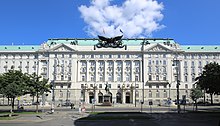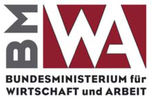Federal Ministry of Economics and Labor (Austria)
|
|||
|---|---|---|---|
| State level | Federation | ||
| Position of the authority | Supreme federal authority | ||
| founding | 2000 ( BMWA with parts of the BMAGS ) | ||
| Dissolved | 2008 (in BMWFJ and BMASK ) | ||
| Headquarters | Vienna 1 , Stubenring 1 | ||
| Authority management | Martin Bartenstein , Federal Minister for Economics and Labor | ||
| Website | http://www.bmwfw.gv.at/ | ||

The Austrian federal administrative body, known as the Federal Ministry of Economics and Labor (for short Ministry of Economics , BMWA , to distinguish it from the pre-ministry also BMWuA ) was primarily responsible for economic policy, trade and industry as well as labor (labor law) from 2000 to 2008.
The Ministry was in government Wolfgang Schüssel as joint Ministry of Economic Affairs of the Federal Ministry of Economic Affairs (BMWA) with the working agenda of the Federal Ministry of Labor, Health and Social formed (BMAGS).
In 2008, when the Federal Government Faymann I took office , the two aspects were separated again and divided between the Federal Ministry of Economics, Family and Youth (BMWFJ, continued Ministry of Economics) and the Federal Ministry of Labor, Social Affairs and Consumer Protection (BMASK, Ministry of Social Affairs)
Federal Minister
In the federal governments of Federal Chancellor Wolfgang Schüssel ( Government I , II ) and Gusenbauer , Martin Bartenstein ( ÖVP ) was Federal Minister for Economics and Labor.
Bartenstein was Federal Minister for the Environment from 1995 to 1996 and Federal Minister for Environment, Youth and Family from 1996 to 2000 . He remained in office as Minister of Economics in the following government.
State Secretary for Labor were Mares Rossmann ( FPÖ , until 2000–2003, Schüssel I) and Christine Marek ( ÖVP , 2007–2008, Faymann cabinet).
Competencies
For the first time since the First Republic , the traditional Austrian separation of business-economic matters and labor market policy, which corresponds to the proportion of “black-blue” ( conservative and liberal ) and “red” ( socialist ) interests, was abolished and both aspects united in an overall economic ministry . For this purpose, various operational matters, which had lost their scope due to the privatization of the public economy , were assigned to the specialist ministries, so road construction and railway matters came to the Ministry of Transport (now BM for Transport, Innovation and Technology - BMVIT, Ministry of Infrastructure ), the water management department was combined Ministry of Agriculture and Environment (now BM for Agriculture, Forestry, Environment and Water Management - BMLFUW, Ministry of Life ).
The BMWA was responsible for:
-
Trade and industry (insofar as these matters do not fall within the scope of the Federal Ministry for Transport, Innovation and Technology ); this includes in particular:
- Commercial law and the right to provide services
- Trade law
- Closing hours matters
- Commercial and industrial research
- Matters of in-company vocational training and professional development
- Mining
- Economic and structural policy
- Organization of the internal market (if these matters are not the responsibility of the Federal Ministry of Agriculture, Forestry, Environment and Water Management )
- Matters of price regulation , price monitoring and price gouging (insofar as they do not fall within the scope of the Federal Ministry for Social Security and Generations )
- Energy being
- Carrying out trade and economic policy matters vis-à-vis foreign countries
- Affairs of the Austrian representation authority at the WTO
- Administration of all federal buildings and properties
- Federal Furniture Administration
- Construction , Housing and Settlement Matters
- Technical testing ; Shelling Matters ; Measurement, weight, calibration and surveying ; Matters of all other technical test and safety marks ; Standards
- Matters of normalization and typing of electrical systems
- Marking and surveying the national borders
- Engineering and civil engineering matters
- Establishment of a security control system and export controls to ensure the peaceful use of nuclear energy
- Regional funding
- State-owned enterprise affairs
- Labor law matters (insofar as they do not fall within the scope of the Federal Ministry of Justice ); this includes in particular:
- Labor market matters ; unemployment insurance
organization
The BMWA was structured as follows:
-
Federal Minister
- cabinet
- Internal
- Budget and administration
- Personnel and Law
- IT and communication
- Center 1 : Economic Policy
- Center 2 : Foreign Trade Policy and European Integration
- Section I : Business and Technology
- Section II : Labor Market
- Section III : Labor Law and Labor Inspection
- Section IV : Energy and Mining
- Section V : Tourism and Historical Objects
- Federal Procurement Office
- Federal Competition Authority
Historical development
The Austrian Ministry of Economic Affairs was formed from a trade and trade ministry (at times also ministry of labor ), industry , energy and construction ministry , with public works (at times also ministry of transport ), which are still derived from the times of the monarchy. After the Second World War, a Federal Ministry for Trade and Reconstruction was established . In 1966, a separate Federal Ministry for Buildings and Technology was created as the Building Ministry for Public Construction, from which the Federal Ministry for Economic Affairs emerged in 1987 in the Federal Government of Vranitzky II through amalgamation with the Federal Ministry of Trade, Commerce and Industry . Only since then has it been known as the "Ministry of Economics", with the building ministers of the Second Republic being named as the predecessors of the economics ministers.
The labor department , i.e. the interests of the workforce , was also created as such in 1987; before that it was traditionally distributed between the ministries of social affairs and the ministries of economics, and was part of the Federal Ministry of Labor and Social Affairs , and from 1997 the comprehensive Federal Ministry of Labor, Health and Social Affairs settled. When the Schüssel government took office , it was merged with the Ministry of Economic Affairs. The federal government Faymann I then exchanged work for family and youth affairs with the Ministry of Social Affairs (as requested by the FCG in 2006 ), since in view of the economic crisis the social aspects of job security predominated. At the same time, the Ministry of Economic Affairs should endeavor to be family- friendly.
- See also tables in the Austrian Ministry of Economics and the Austrian Ministry of Labor
Web links
- Federal Ministry of Economics and Labor, www.bmwa.gv.at ( Memento from April 6, 2005 in the Internet Archive )
Individual evidence
- Ministry of Economic Affairs, Federal Ministry of Economics and Labor , no longer maintained version of the Austrian Lexicon AEIOU, current article: Entry on the Ministry of Economic Affairs in the Austria Forum (in the AEIOU Austria Lexicon )
- ↑ Entry on the Ministry of Commerce in the Austria Forum (in the AEIOU Austria Lexicon )
- ↑ Entry on the Ministry of Economic Affairs in the Austria Forum (in the AEIOU Austria Lexicon )
- ↑ FCG: Separation of the Ministry of Economics and Labor would be an appreciation for the work . OTS0042, December 15, 2006.
| predecessor | Federal Ministry of Economics and Labor BMW (u) A departments : |
successor |
|---|---|---|
|
Federal Ministry for Economic Affairs BMWA |
Austrian Ministry of Economic Affairs April 1, 2000 - January 31, 2009 |
Federal Ministry for Economy, Family and Youth BMWFJ |
|
Federal Ministry of Labor, Health and Social Affairs BMAGS |
Austrian Ministry of Labor April 1, 2000 - January 31, 2009 |
Federal Ministry of Labor, Social Affairs and Consumer Protection BMASK |
